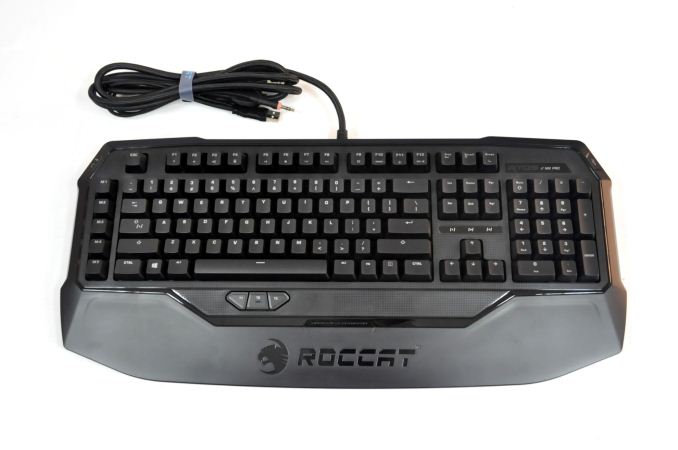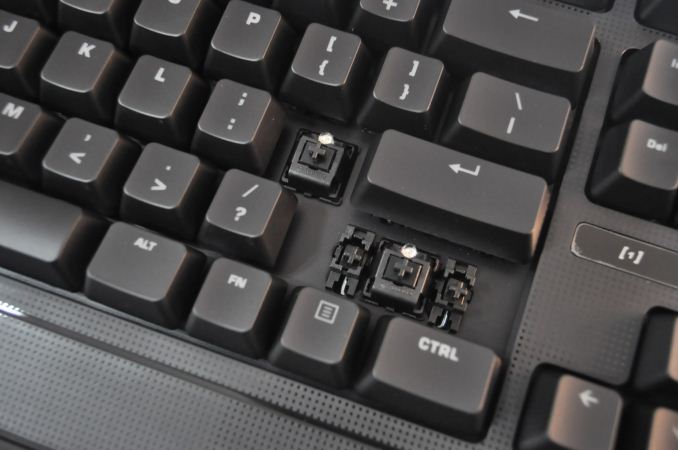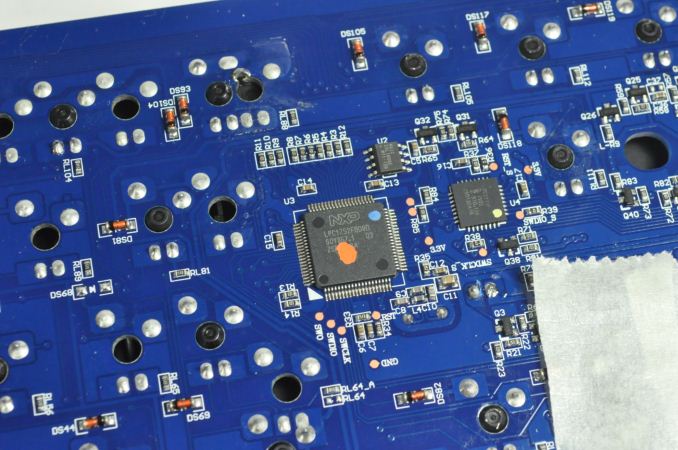ROCCAT Ryos MK Pro Mechanical Gaming Keyboard Capsule Review
by E. Fylladitakis on December 31, 2014 10:00 AM EST- Posted in
- Keyboard
- Gaming
- ROCCAT
- Mechanical Keyboards
The ROCCAT Ryos MK Pro Gaming Keyboard
The first thing that you will notice about the ROCCAT Ryos MK Pro gaming keyboard is its massive proportions. Despite having only five extra macro keys to the left side of the board and three below the Space Bar, the Ryos MK Pro is 51cm wide and 23.5cm tall (20" by 9.25"), making it one of the largest keyboards that we have ever seen. The integrated and, sadly, non-removable wrist rest is the main reason this keyboard requires so much desk space.
No doubt it was necessary for ROCCAT to increase the proportions of the keyboard due to the inclusion of the thumb keys and they chose to do so by integrating the large wrist rest. The entire body of the keyboard is plastic and has been sprayed with a matte black paint, with glossy black cosmetic accents. ROCCAT advertises the body as being "smudge-proof" and that is partially true, as none of the plastic parts will get dirty easily – but that of course does not mean that the Ryos MK Pro cannot get dirty at all.
Aside from the eight extra Macro keys, there are no additional keys on the Ryos MK Pro, including multimedia and volume control keys. The multimedia controls are restricted to button combinations, i.e. holding the FN key and pressing one of the Function keys. For example FN + F1 will mute the sound, FN + F4 will bring up the calculator, and FN + F12 will initiate the on-the-fly macro recording. Furthermore, FN + Pause/Break will put the computer to sleep. The LED indicators for the Lock keys have been placed between the arrow keys and the document navigation keys.
Cherry is the supplier of the mechanical switches of this keyboard. They are the world's most renowned manufacturer of mechanical keyboard switches – and for a good reason. Our testing has proven that they tend to be more consistent than most competitive products at this point in time. We received the Ryos MK Pro with MX Black switches, but ROCCAT also offers it with Red, Blue, and Brown switches, allowing the users to select whichever switch suits them best. (Note that the current online pricing varies slightly depending on the choice of switch, with Black being the least expensive and Blue/Red costing the most.) ROCCAT implemented the switches very well, mounting them on a strong board and using cross-type supports under all of the larger keys.
One of this keyboard's most notable features is the inclusion of 3.5" audio jacks and a USB 2.0 hub. The audio jacks and the USB 2.0 ports can be found very thoughtfully placed at the top left and right corners of the keyboard, respectively.
ROCCAT was certainly not joking around when they added "super-stable support" in the list of this keyboard's features. There are five very large anti-skid pads beneath the Ryos MK Pro, making the plastic body of the keyboard very difficult to slip on any surface. Two height adjustment feet can be seen near the top of the body.
The backlighting is perhaps the most important and notable feature of the Ryos MK Pro. Every key, including the thumb macro keys, has a very strong blue LED installed. The controller features per-key illumination, allowing the user to tweak or turn off the illumination of each different key. There are several lighting programming options in the software, which we will cover on the following page.
The removal of the top plastic cover reveals the metal board that the keys and the main PCB are mounted on, as well as a lot of hollow space where the wrist rest is. ROCCAT performed an excellent assembly job – everything is very well secured, the cables are cleverly routed, and the soldering job is immaculate. There are two microcontrollers inside the Ryos MK Pro. The main microcontroller is the NPX LPC1752FBD80, with an NPX LPC1111/102 next to it. A Cypress CY7C65642 USB 2.0 controller can also be seen, managing the hub.



















21 Comments
View All Comments
erple2 - Wednesday, December 31, 2014 - link
Interesting. I guess the analysis is limited to the software, as the keys (and therefore the feel of typing) are a known quantity at this time.Has anyone done a review of the other mechanical switches, namely buckling spring? I can't find (conveniently) any cherry MX switch based keyboards locally to test out the feel compared with my Unicomp keyboard (which I really like, at least for typing and casual gaming - while I like a good fps, I'm too old to be good at twitch fpsing). I don't ming the clackety clack of buckling springs at all.
Also what the heck is up with wasd?? Why did people migrate to that instead of esdf???! It doesn't make any sense to me to move your hands from home for.. But maybe that's my age.
Novaguy - Wednesday, December 31, 2014 - link
Re: wasd vs. esdf, i imagine the advantage of wasd includes easier reaching shift and control keys as well as a more neutral left shoulder angle.I personally gave up the wasd and now use a logitech g13 and put my keyboard away.
Impulses - Wednesday, December 31, 2014 - link
Well, you can always move the keyboard so ESDF lines up and depending on how nimble your fingers are you then have access to the shift/ctrl keys as well as a bunch of extra letter keys on your pinky side... Basically you have more keys within overall reach.I'd love a G13 with mechanical cherry red switches tho... In fact, that would kill my curiosity to try a TKL board. I could keep the Corsair K90 I like with media keys and macro keys for everything else (which I use for Photoshop/LR more than gaming) and just slide it back for gaming.
I'm surprised Logitech's never built one with all the rage over mechanical switches the last few years.
Impulses - Wednesday, December 31, 2014 - link
Dunno, maybe it's because WASD is a little easier to find by blind feel if you've taken your hand off the keyboard? I started off with WASD but I've used ESDF occasionally on MMOS which require lots of peripheral keys.I'm sure there's reviews of buckling spring boards out there since they're still sold and refurbished, could try the geekhack boards... I'm sure there's people using them on the AT/Hard/OCN boards too tho.
Then there's Topre too... Anyway, if you just wanna test out the feel of cherry switches you can order a little sampler board (like 4-8 keys usually) with various switch types.
Blues probably give the most feedback and might feel the closest to buckling springs but it's subjective. Best Buy used to carry a Razer board with blues FWIW.
DanNeely - Wednesday, December 31, 2014 - link
My local BB only claimed to carry one to the internet. I visited the store twice hoping to get my hands on it; only to only see the usual assortment of cheap Generic/MS/Logitech keyboards. The second time, I verified on BB.com that it was there before leaving work at the end of the day; got to the store couldn't find it; used one of their computers to visit the in store version of their site which said they didn't have it; went home and checked BB.com which again claimed the store had it in stock. Sooner or later I want to visit the store with a copy of bb.com claiming it's in stock loaded on my phone to harass the blueshirts about; but I haven't had any other excuse to go there for a while and don't want to make a special trip just for that.piiman - Saturday, January 3, 2015 - link
Just in case you don't know BB keeps keyboards in two different areas. One has the normal cheap and wireless stuff and then they have the gaming stuff in another area.knightspawn1138 - Wednesday, December 31, 2014 - link
I never liked WASD or ESDF. I hated how cramped my fingers got being squished up like that, so I've always had to remap my games to ASDF. I set them up as A=back, S=strafe left, D=strafe right, and F=forward. I find I can use more of the peripheral keys, still have my pinky available for modifier keys (since most games don't have me running or crouching backwards), and my hand never has to leave the home row. And even if I do pick up my hand, I can quickly find home row on keyboards that have a bump on either the D or F keys. And it's just more comfortable for long sessions of gaming.But it is a PITA to setup a profile that works well since I have to modify just about every key around ASDF. But, it takes just as long (or longer) to setup my Logitech G13, so I can't complain too much.
JohnMD1022 - Thursday, January 1, 2015 - link
Having tried Cherry-based keyboards, I still prefer my 1987 IBM Model M Space Saver.Has anyone thought of licensing buckling spring technology?
erple2 - Friday, January 2, 2015 - link
Check out the Unicomp store. That's where I bought mine from in about 2010. Pckeyboard dot com. I got the spacesaver USB model. Unicomp wound up buying the license to make the buckling spring from IBM, and made all of their keyboards after about 1987 ish.piiman - Saturday, January 3, 2015 - link
"Also what the heck is up with wasd?? Why did people migrate to that instead of esdf???! It doesn't make any sense to me to move your hands from home for.. But maybe that's my age."LOL I was noticing that to the other day and noticed it has made me shift my hands left and now my touch typing is all off since my hands don't rest on the HOME keys a,s,d,f and instead now rest on the Cap lock,a,s,d much of the time. so I end up TyPing likE tHiS a loT. :-)